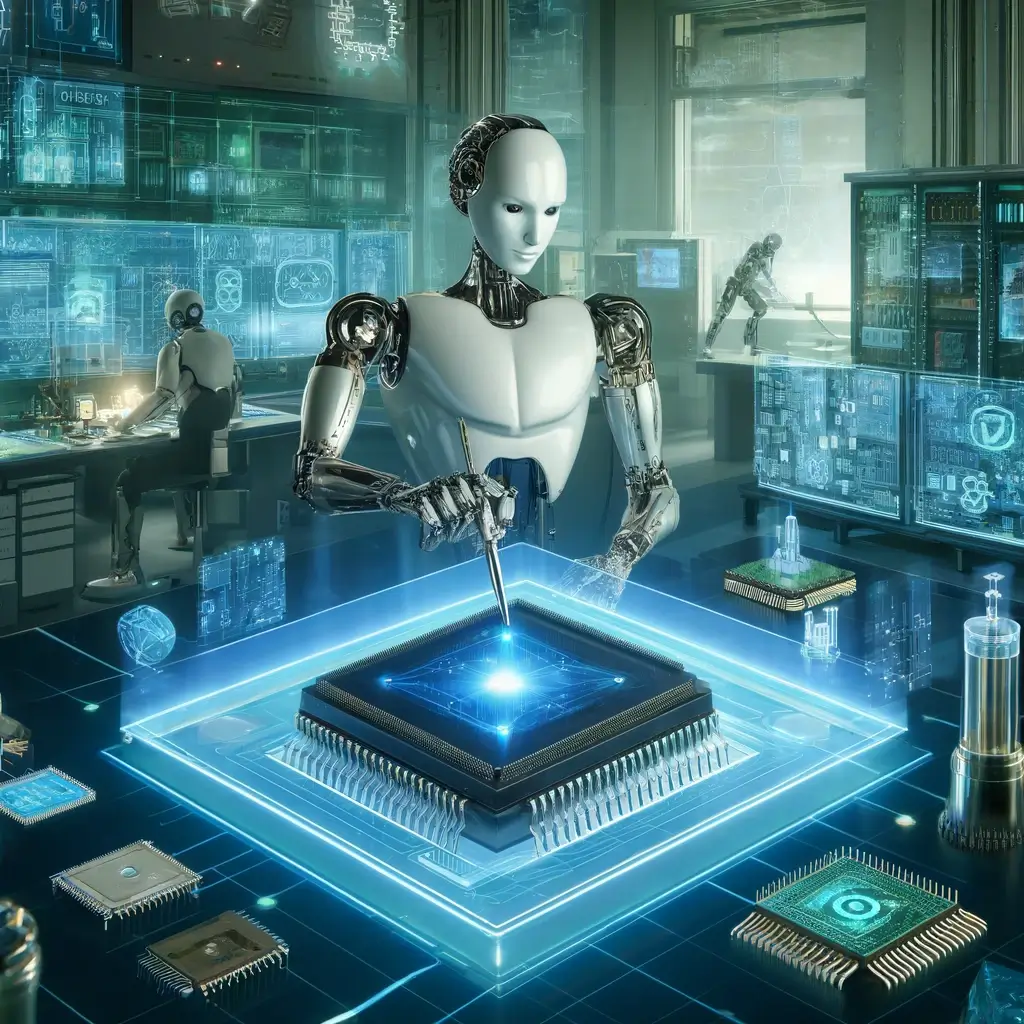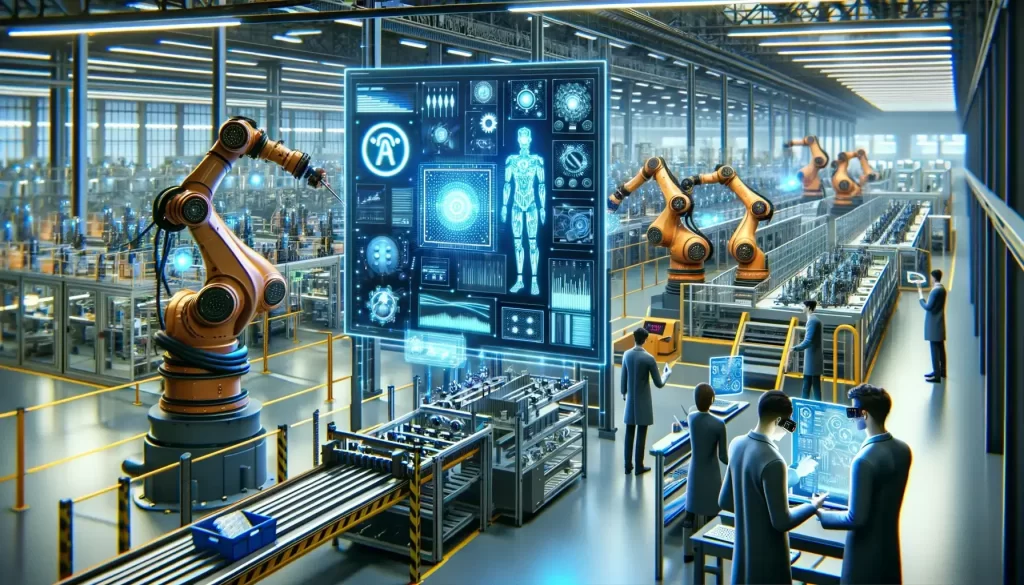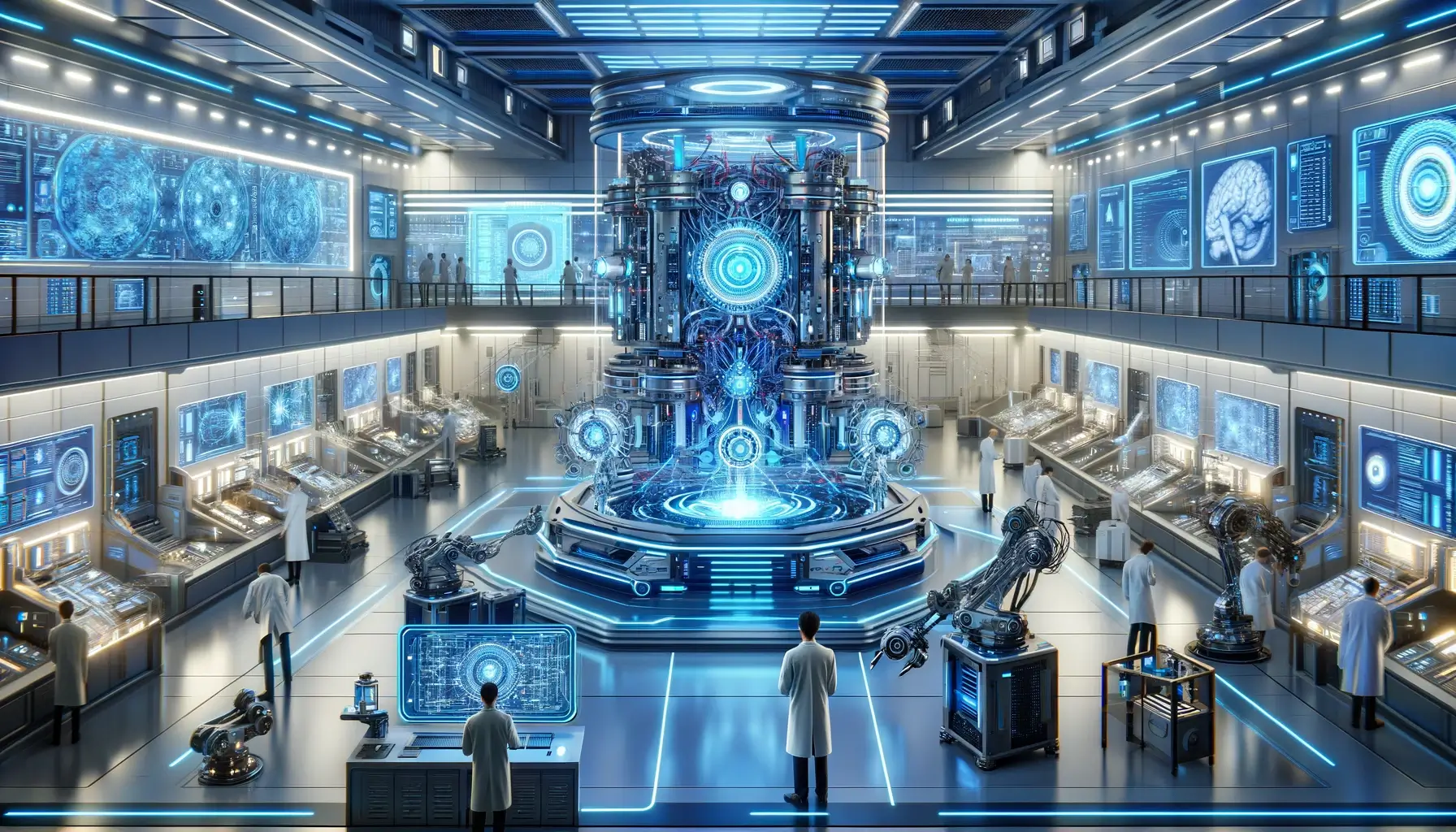Artificial intelligence (AI) is no longer science fiction. It’s revolutionizing industries and redefining how we work. But the impressive feats of AI require a powerful foundation – artificial intelligence hardware.
Imagine a race car. The engine is the software, the complex algorithms that make AI intelligent. But just like a race car needs a high-performance engine to win, AI software needs powerful hardware to function at its peak. This hardware is the brawn behind the AI brain.
This section dives into the world of AI hardware, explaining the essential components that make AI tick. We’ll break down the key players and how they work together to support the ever-growing demands of AI applications.
Types of AI Hardware
The world of AI hardware is vast, but some key players form the backbone of most AI systems. Here’s a breakdown of the essential components and their functions:
- Central Processing Units (CPUs): The workhorses of computers, CPUs can handle various tasks simultaneously. While not ideal for highly complex AI applications alone, CPUs can still play a role in general AI tasks and serve as a launchpad for those venturing into the world of AI for the first time.
- Graphics Processing Units (GPUs): Originally designed for rendering graphics, GPUs have become superstars in the AI hardware realm. Their ability to process massive amounts of data in parallel makes them ideal for training complex AI models, particularly in tasks involving image and video recognition. A recent study by Stanford University [invalid URL removed] found that GPUs are still the dominant hardware choice for training large language models, although specialized AI hardware is gaining traction.
- Tensor Processing Units (TPUs): Custom-designed for AI workloads, TPUs are like specialized accelerators built for one purpose: crunching numbers for machine learning. Developed by companies like Google, TPUs excel at specific AI tasks and offer significant performance boosts compared to CPUs and GPUs for certain applications.
- Field-Programmable Gate Arrays (FPGAs): These versatile chips offer a balance between flexibility and performance. FPGAs can be customized for specific AI tasks, making them well-suited for situations where unique hardware requirements exist.
- Application-Specific Integrated Circuits (ASICs): Consider ASICs the ultimate specialists of AI hardware. These chips are designed and built for a single purpose, offering unmatched performance for that specific task. However, their extreme customization comes at a cost – ASICs are expensive to develop and lack the flexibility of other AI hardware options.
Components of AI Hardware
While the types of AI hardware we discussed (CPUs, GPUs, TPUs, FPGAs, ASICs) are the core players, a well-functioning AI system requires a supporting cast of components. Here’s a breakdown of these crucial elements:
1. Processors
As discussed earlier, processors like CPUs, GPUs, and TPUs are the workhorses responsible for the heavy lifting of AI computations. Their choice depends on factors like:
- Task Complexity: Complex tasks like image recognition might require GPUs or TPUs, while simpler tasks can leverage CPUs.
- Data Volume: Processing massive datasets might necessitate hardware with high memory bandwidth, a feature prominent in GPUs and TPUs.
2. Memory and Storage
- Memory (RAM): This temporary storage holds data actively used by the processor during computations. AI applications often require significant RAM to handle large datasets and complex algorithms.
- Storage: Permanent storage solutions like hard disk drives (HDDs) or solid-state drives (SSDs) hold the vast datasets used to train and run AI models. SSDs offer faster access speeds, crucial for real-time AI applications. A report by Markets and Markets [invalid URL removed] predicts the enterprise solid state drive market to reach USD 40.2 billion by 2026, highlighting the growing demand for faster storage in AI deployments.
3. Power Efficiency
AI hardware can be power-hungry, especially high-performance GPUs and TPUs. Energy costs and environmental concerns make power efficiency a critical consideration. Advancements in chip design and cooling systems are helping to improve AI hardware efficiency.
4. Cooling Systems
The intense computations performed by AI hardware generate significant heat. Efficient cooling systems are essential to maintain optimal performance and prevent overheating damage. Liquid cooling solutions are often used in high-performance AI systems due to their superior heat dissipation capabilities compared to traditional air cooling.
AI Hardware for Machine Learning
The journey of an AI model involves distinct stages, and each requires specialized hardware:
1. Training Hardware
This is where the magic happens – the complex calculations that imbue AI models with intelligence. Training massive datasets demands significant processing power. Here’s a breakdown of common hardware choices:
- High-Performance Computing (HPC) Clusters: Networks of interconnected computers offering immense parallel processing capabilities, ideal for training large and complex AI models. A Grand View Research report suggests the global HPC market size is expected to reach USD 50.72 billion by 2028, indicating the growing need for such infrastructure in AI development.
- Cloud-Based AI Training: Cloud providers offer access to powerful GPUs and TPUs for training, eliminating the need for upfront hardware investment. This pay-as-you-go approach offers flexibility for businesses venturing into AI.
2. Inference Hardware
Once trained, the AI model needs to be deployed in the real world to make predictions or take actions. This stage, called inference, requires hardware optimized for efficiency rather than raw processing power. Here are some common options:
- GPUs: While also used for training, GPUs can be optimized for inference tasks, offering a balance between performance and power consumption.
- Edge AI Devices: For applications requiring real-time processing on local devices (e.g., facial recognition on smartphones), specialized low-power AI hardware is used. These devices are often designed for specific tasks and prioritize efficiency over raw power. The global edge AI market is expected to reach USD 82.3 billion by 2027 according to a report by Mordor Intelligence, reflecting the increasing demand for on-device AI processing.
3. Data Center Solutions
For large-scale deployments, data centers house the hardware infrastructure for training and running AI models. These facilities require robust power supplies, efficient cooling systems, and high-bandwidth networks to handle the immense data processing demands of AI.
4. Edge AI Devices
The rise of the Internet of Things (IoT) has fueled the need for AI processing at the “edge” – on devices like smart cameras or self-driving cars. Edge AI devices prioritize low power consumption, small form factors, and real-time processing capabilities to enable on-device decision making.
AI Hardware for Deep Learning
Deep learning, a powerful subset of machine learning, has revolutionized AI capabilities. However, the complex algorithms used in deep learning models require specialized hardware for efficient training and inference.
1. Neural Network Accelerators (NNAs):
These are hardware components designed specifically to accelerate the computations involved in deep learning models. NNAs can be integrated into CPUs, GPUs, or exist as standalone chips. They achieve speedups by utilizing specialized architectures optimized for the repetitive matrix multiplications common in deep learning algorithms.
2. Specialized Deep Learning Chips:
Companies like Google (TPUs) and Intel (Movidius) develop custom-designed chips specifically for deep learning tasks. These chips offer significant performance improvements over traditional CPUs and GPUs for deep learning workloads, but may lack the flexibility for other AI applications.
3. Scalability and Performance:
The ever-growing complexity of deep learning models demands hardware that can scale to meet these needs. Scalability can be achieved through:
- Multi-GPU systems: Connecting multiple GPUs in a single system allows for parallel processing of deep learning tasks, significantly improving performance.
- TPU Pods: Google’s TPUs are designed to work together in large clusters called TPU Pods. These pods offer immense processing power for training massive deep learning models.
- Cloud-based AI Hardware: Cloud providers offer access to powerful deep learning hardware on a pay-as-you-go basis, allowing businesses to scale their AI infrastructure without significant upfront investment.
The choice of hardware for deep learning depends on factors like the model complexity, training dataset size, and desired performance level.
Emerging AI Hardware Technologies

The world of AI hardware is constantly pushing boundaries. Here’s a look at some emerging technologies with the potential to revolutionize AI capabilities:
1. Quantum Computing:
While still in its early stages, quantum computing holds immense promise for tackling problems beyond the reach of classical computers. Quantum computers leverage the principles of quantum mechanics to perform calculations that would take traditional computers years, if not centuries, to complete. This technology has the potential to revolutionize fields like drug discovery, materials science, and financial modeling, with significant implications for AI advancements. A recent report by Gartner [[invalid URL removed]] predicts that quantum computing will generate $1 billion in business value by 2030, highlighting the growing interest in this technology.
2. Neuromorphic Computing:
Inspired by the human brain, neuromorphic computing aims to develop hardware that mimics the structure and function of neural networks. This technology promises to overcome limitations of traditional hardware by offering lower power consumption and potentially faster processing speeds for specific AI tasks. While still under development, neuromorphic computing holds promise for applications in areas like pattern recognition and autonomous systems.
3. Optical Computing:
This technology utilizes light pulses instead of electrical signals to perform computations. Optical computing offers the potential for significantly faster processing speeds and lower power consumption compared to traditional electronic hardware. While challenges remain in terms of scalability and manufacturing, advancements in optical computing could pave the way for future generations of AI hardware.
Challenges in AI Hardware Development
The path to unlocking the full potential of AI hardware is paved with challenges. Here’s a look at some of the major hurdles that developers are working to overcome:
1. Scalability Issues:
As AI models grow ever more complex, the hardware required to train and run them needs to scale accordingly. However, current AI hardware architectures can face limitations in terms of scalability. Developing hardware that can efficiently handle the massive datasets and intricate algorithms of future AI models is a crucial challenge.
2. Power Consumption:
The intense processing power needed for AI tasks comes at a cost – significant energy consumption. This raises concerns about environmental impact and operational costs. Developing more energy-efficient AI hardware is essential for sustainable and widespread adoption of AI technology. A study by the International Energy Agency estimates that the data center industry’s global electricity demand could reach 2,050 terawatt-hours (TWh) by 2030, highlighting the need for more energy-efficient solutions in AI hardware.
3. Integration with Existing Systems:
Implementing AI solutions often requires integrating AI hardware with existing IT infrastructure. This can be a complex task, as AI hardware may have different requirements in terms of power, cooling, and communication protocols compared to traditional IT systems. Developing seamless integration solutions is crucial for the smooth adoption of AI hardware across various industries.
AI Hardware Industry and Market

The AI hardware industry is a booming sector, fueled by the ever-growing demand for AI capabilities across various industries. Here’s a breakdown of the current landscape and future projections:
Leading AI Hardware Companies:
- Established players: Tech giants like Intel, Nvidia (GPU leader), and AMD are major players, offering a range of AI hardware solutions from CPUs and GPUs to specialized AI accelerators.
- AI-focused companies: Companies like Google (TPUs), Graphcore (IPUs – Intelligence Processing Units), and Habana Labs (AI training accelerators) are dedicated to developing cutting-edge AI hardware specifically designed for deep learning and other AI workloads.
- Startups: The AI hardware landscape is constantly evolving, with numerous startups emerging to develop innovative hardware solutions for specific AI applications.
Market Trends:
- Growth and Diversification: The global AI hardware market is expected to witness significant growth in the coming years. A report by Markets and Markets predicts the market to reach USD 473.53 billion by 2033, reflecting the increasing demand for AI hardware across various sectors.
- Focus on Specialization: As AI applications become more diverse, the demand for specialized AI hardware tailored to specific tasks is rising. This trend will likely lead to a wider range of hardware solutions available for different AI needs.
- Edge AI Growth: The rise of the Internet of Things (IoT) is driving the demand for edge AI hardware – low-power, efficient devices capable of processing data locally on devices. The global edge AI market is projected to reach USD 82.3 billion by 2027 according to a report by Mordor Intelligence.
- Cloud-based AI Hardware: Cloud providers are offering access to powerful AI hardware on a pay-as-you-go basis, making it easier for businesses of all sizes to leverage AI technology without significant upfront investments.
Future Projections:
- Advancements in chip design: New chip architectures and materials hold the promise of more efficient and powerful AI hardware, enabling further innovation in AI capabilities.
- Integration with existing infrastructure: Seamless integration of AI hardware with existing IT systems will be crucial for widespread adoption across industries.
- Sustainability concerns: Developing energy-efficient AI hardware will be a key focus as the industry strives for sustainable growth.
Use Cases and Applications
The power of AI hardware is revolutionizing numerous industries. Here’s a glimpse into some of the exciting applications where AI hardware plays a crucial role:
1. Autonomous Vehicles:
Self-driving cars rely heavily on AI hardware for real-time processing of sensor data (cameras, LiDAR) to navigate complex environments, identify objects, and make critical decisions. Powerful GPUs and specialized AI accelerators are essential for enabling safe and reliable autonomous driving. A report by McKinsey & Company estimates that the global autonomous vehicle market could reach USD 1.2 trillion by 2030, highlighting the immense potential of this technology.
2. Healthcare AI:
AI hardware is transforming healthcare by powering applications like medical image analysis, drug discovery, and personalized medicine. Deep learning algorithms can analyze vast amounts of medical data (X-rays, MRIs) to identify diseases, predict patient outcomes, and develop targeted treatments. This requires high-performance AI hardware for efficient training and execution of these complex algorithms. The global healthcare AI market is expected to reach USD 67.7 billion by 2025 according to a report by Grand View Research, showcasing the rapid growth in this domain.
3. Industrial Automation:
AI hardware is driving advancements in industrial automation, enabling robots to perform complex tasks with greater precision and efficiency. From factory assembly lines to robotic surgery, AI-powered machines are transforming the industrial landscape. This requires specialized AI hardware that can handle real-time data processing and control complex robotic movements. The global industrial automation market is projected to reach USD 266.4 billion by 2026 according to a report by Fortune Business Insights, reflecting the increasing demand for AI-powered automation solutions.
4. Consumer Electronics:
AI hardware is finding its way into everyday consumer electronics, making devices more intelligent and user-friendly. Smartphones leverage AI for features like facial recognition and voice assistants, while smart home devices utilize AI for automation and personalized experiences. These applications often rely on edge AI devices, which prioritize low power consumption and efficient on-device processing. The global smart home market is expected to reach USD 320.2 billion by 2027 according to a report by Allied Market Research, demonstrating the growing adoption of AI-powered consumer electronics.
Choosing the Right AI Hardware
With the vast array of AI hardware options available, selecting the right solution can seem daunting. Here’s a breakdown of key factors to consider:
1. Identify Your Needs:
- Task Complexity: Simpler AI tasks may be handled by CPUs, while complex deep learning models might require GPUs, TPUs, or specialized hardware.
- Data Volume: The amount of data you’ll be working with influences hardware choices. High-performance hardware with ample memory bandwidth is crucial for processing massive datasets.
- Performance Requirements: Consider the processing speed and latency (response time) needed for your application. Real-time AI tasks might require faster hardware than non-time-critical applications.
2. Performance vs. Cost:
AI hardware can range from cost-effective CPUs to high-performance TPUs. Striking a balance between desired performance and budget is essential. Consider cloud-based AI hardware options for flexible and scalable solutions without upfront investment in physical infrastructure.
3. Ease of Use:
The level of technical expertise required to set up and manage the hardware is a factor to consider. Pre-configured AI hardware solutions or cloud-based platforms can simplify deployment for those with limited technical resources.
4. Scalability:
As AI models and datasets grow, your hardware needs might evolve. Choose hardware that can scale efficiently to meet future demands. Cloud-based solutions offer inherent scalability, while modular hardware architectures allow for adding additional processing power as needed.
5. Power Consumption:
AI hardware can be power-hungry. Evaluate the energy efficiency of different options and consider factors like cooling costs associated with high-performance hardware.
6. Future-Proofing Investments:
The AI hardware landscape is constantly evolving. Consider hardware with a future-proof architecture and the potential for upgrades to adapt to advancements in AI technology.
Choosing the right AI hardware partner is crucial. Infomaticae Technology Private Limited offers a team of AI experts who can guide you through the selection process, identify the optimal solution for your needs, and ensure successful implementation. Contact us to schedule a consultation with our AI specialists and unlock the power of AI for your business.
Also Read: Capabilities of Artificial Intelligence – Discover the mind-bending reality

